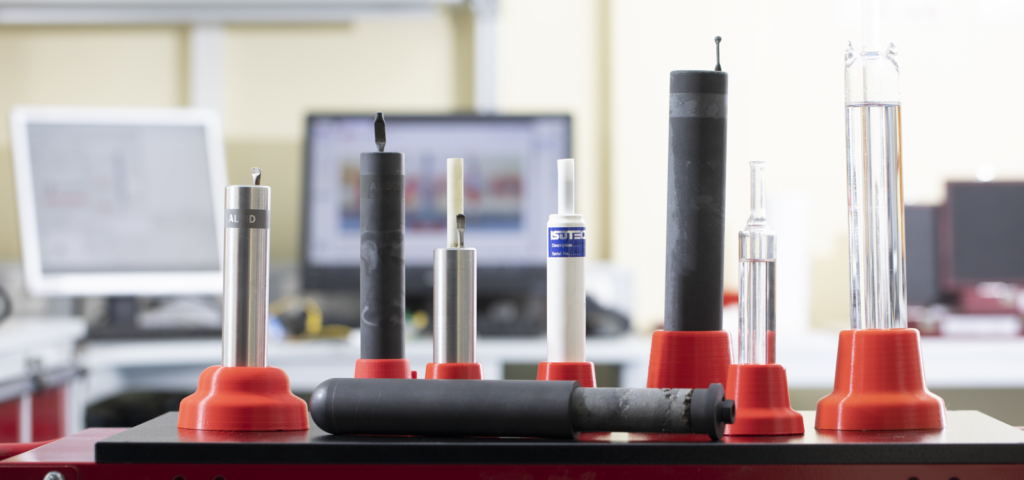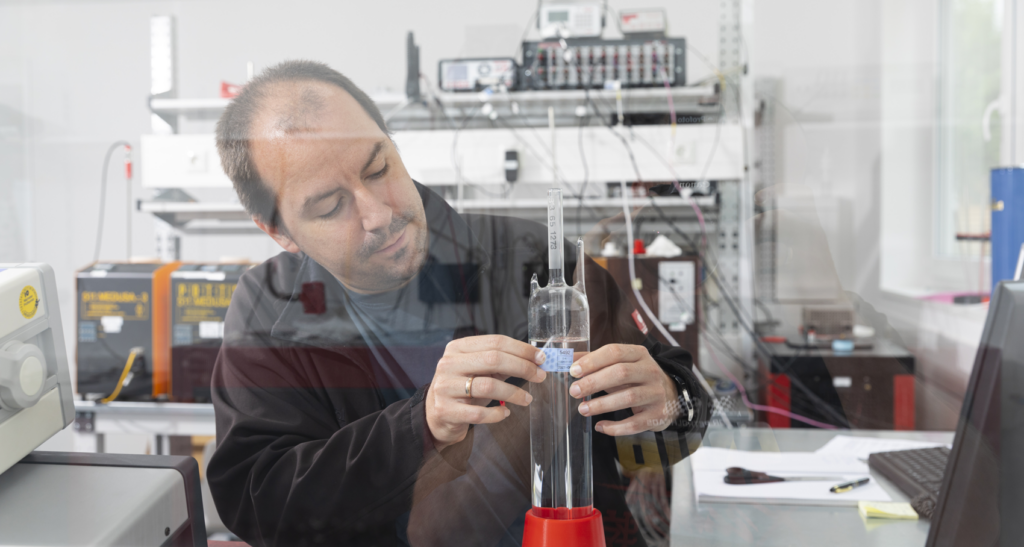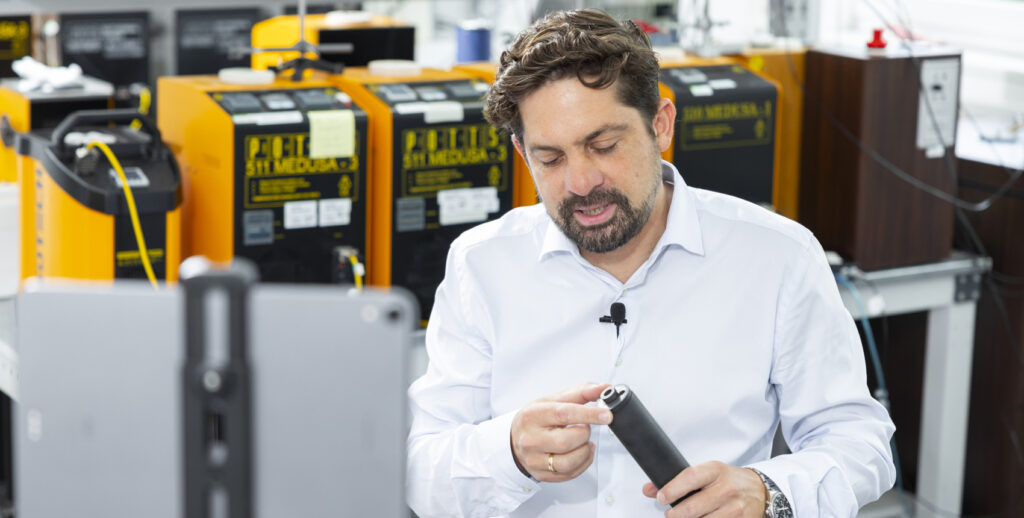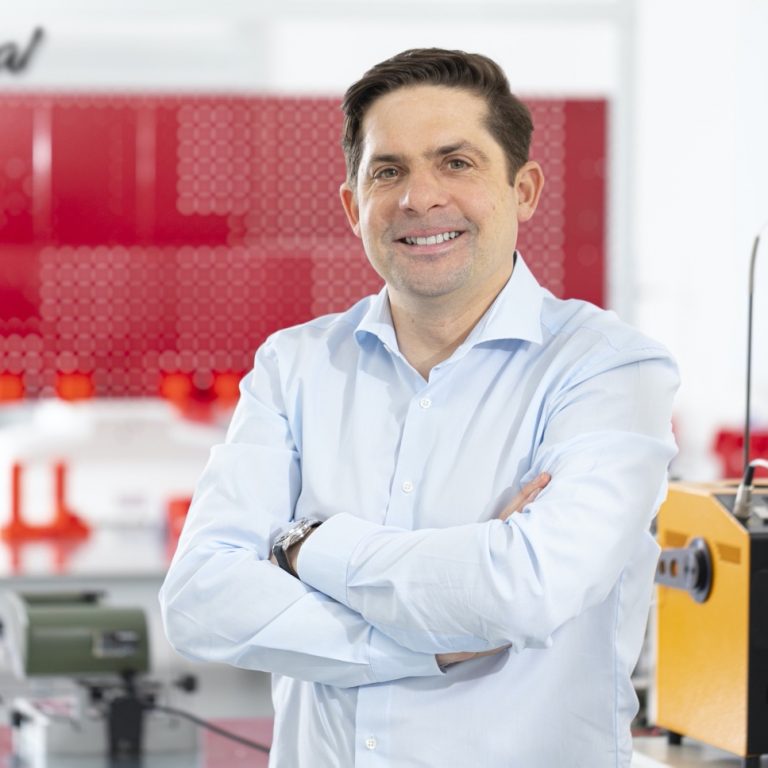Calibrating a thermometer is the process of ensuring that a thermometer provides accurate temperature measurements. This is done by comparing the thermometer’s readings with a reference standard (for example, a temperature fixed point) or a known temperature source (comparative calibration). The goal of calibration is to identify and, if necessary, adjust any deviations or errors so that the thermometer provides accurate measurements.
Content
Methods for Calibrating Thermometers
Fundamentally, there are two different methods for calibrating thermometers: calibration using the comparison method and calibration at temperature fixed points.
Calibrating Thermometers Using the Comparison Method

The calibration of thermometers using the comparison method is based on comparing a thermometer to be calibrated with an already calibrated thermometer. This principle is based on the Zeroth Law of Thermodynamics, which was formulated by Sir William Thomson (Lord Kelvin) in 1848. Although it was developed last among the four laws of thermodynamics, it has been designated as the “Zeroth Law” due to its fundamental importance.
The Zeroth Law states that if two systems are each in thermal equilibrium with a third system, they are also in thermal equilibrium with each other. Based on this law, one can conclude that if a calibrated thermometer shows the same temperature as the actual temperature in a calibration bath, and the thermometer to be calibrated also shows this temperature, both thermometers are measuring the same temperature. However, this only applies under the condition that an equilibrium state exists, which is not always the case in the real world.
The comparison method is one of the most common and efficient techniques for calibrating thermometers. The thermometer being tested is compared with a high-precision reference thermometer whose measurement accuracy and traceability to national or international standards are ensured.
Thermometer Calibration Process
- Preparation for calibration:
• The thermometer to be tested and the reference thermometer are prepared. Both must be clean and in perfect condition.
• A stable calibration device, such as a calibration bath or a dry-block calibrator, is set to the target temperature. These devices ensure a homogeneous and stable temperature distribution. - Define temperature points:
• Calibration is typically performed at several calibration points within the thermometer’s measurement range, e.g., at 0 °C, 50 °C, and 100 °C. The points may vary depending on the application. - Perform comparative measurement:
• Both thermometers are simultaneously inserted into the calibration device, ensuring they are at the same temperature. This minimizes temperature gradients and ensures precise results.
• Once the temperature in the calibration device is stable, the measurements of the reference thermometer and the thermometer under test are recorded. - Analyze deviations:
• Calibration means “determining a deviation”. The difference between the displayed values of the reference thermometer and the thermometer being calibrated is determined. These deviations are documented and can be used for adjustment if necessary.
Advantages of the Comparison Method
- High accuracy: Thanks to the use of a precise reference thermometer and stable calibration devices, the results are very reliable.
- Flexibility: The method is suitable for various types of thermometers, including liquid, resistance, or infrared thermometers.
- Efficiency: Multiple thermometers can be calibrated simultaneously, making the method particularly economical in practice.
Typical Areas of Application
The comparison method is frequently used in testing laboratories, industry, and calibration laboratories, especially when high accuracy is required. It is ideal for routine calibrations and quality assurance in processes where precise temperature measurements are crucial.
Calibrating Thermometers at Temperature Fixed Points

When calibrating thermometers at temperature fixed points, a so-called temperature fixed point serves as the temperature standard instead of a calibrated reference thermometer. These temperature fixed points are used as defining temperatures of the ITS-90 temperature scale and for calibrating thermometers.
The International Temperature Scale of 1990 (ITS-90) defines the temperature scale using nine fixed points in the range from -189.3442°C (triple point of argon) to 961.78°C (freezing point of silver). These fixed points are thermodynamic equilibrium states during the phase transitions of pure substances.
An example of a fixed point is the triple point of water, where ultra-pure water exists in solid, liquid, and gaseous states at 0.01°C. This state can then be used in a water triple point cell to calibrate thermometers at this defined temperature.
How Often should a Thermometer be Calibrated?
There is no absolute or definitive answer to this question. The frequency of thermometer calibration generally depends on various factors:
- Purpose of the thermometer: A thermometer used in critical applications such as medicine or the food industry may need to be calibrated more frequently than a simple household thermometer.
- Accuracy requirements: Some processes require very high temperature accuracy. In such cases, regular calibration is essential.
- Environmental conditions: Thermometers used under extreme conditions (e.g., very high temperatures) may be more susceptible to inaccuracies and should therefore be checked more frequently.
- Previous calibration results: If no or only minor deviations were found during previous calibrations, the time between calibrations may possibly be extended. However, if significant deviations are found at each calibration, the calibration frequency should be increased.
As a general rule, critical thermometers should be calibrated at least once a year. However, in some industries or for certain applications, more frequent calibration may be required, such as every three or six months. It is always a good idea to include regular checks and calibration in the maintenance schedule to ensure that the thermometer is functioning correctly.
One can also refer to standards and guidelines when determining calibration cycles. For example, DIN EN ISO/IEC 17025 is an international standard that sets requirements for the competence of testing and calibration laboratories. If a laboratory is accredited to this standard, it means that it has the technical competence and has established a management system to ensure the production of consistent and valid results.
The calibration of measuring instruments, including thermometers, is an important component of this standard. Some main points regarding calibration from DIN EN ISO/IEC 17025 are:
- General requirements: Laboratories must ensure that all equipment that could influence the results is calibrated and/or qualified.
- Intervals: The standard does not prescribe specific calibration intervals. Instead, laboratories should use their risk management to determine the frequency of calibrations.
- Traceability: Calibrations should be traceable to national or international standards.
- Records: Laboratories must maintain records of calibrations, including details on the method, operator, environmental conditions, confirmation intervals, results, and any deviations.
The German Accreditation Body (DAkkS) has additional documents and regulations that contain specific requirements and recommendations for calibration in various fields. If a laboratory in Germany is accredited according to DIN EN ISO/IEC 17025, it must also follow the relevant DAkkS rules.
A laboratory accredited to DIN EN ISO/IEC 17025 must have a clear policy and procedures for calibrating its equipment. However, the exact frequency of calibration is determined by the laboratory itself, based on its risk management and the specific requirements of its accreditation.

In Our Own Interest
Calibration Service by Klasmeier
Klasmeier offers accredited calibrations according to DIN EN ISO/IEC 17025 (DAkkS) for various temperature measuring devices, including resistance thermometers, thermocouples, and temperature fixed points. The service includes high-precision calibrations over a wide temperature range and is supported by state-of-the-art technology and extensive experience. The offering is aimed at both industrial and scientific applications.
National and International Standards for Thermometer Calibration
Thermometer calibration plays an important role in measurement technology, especially in industries where precise temperature measurements are necessary. National and international standards provide clear guidelines for conducting and documenting these calibrations.
International Standards
- ISO/IEC 17025: This standard defines the general requirements for the competence of calibration laboratories. It ensures that calibration results are internationally comparable and traceable.
- ITS-90: The International Temperature Scale of 1990 provides a reference for calibrating thermometers through defining temperature fixed points. It also defines Standard Platinum Resistance Thermometers (SPRT) as interpolation instruments.
- IEC 60584: This standard regulates thermocouples and their thermoelectric voltages, which are important for accurate temperature measurements.
- IEC 60751: The standard describes requirements for platinum resistance thermometers (RTDs), which are frequently used in high-precision applications.
National Standards and Guidelines
- DIN EN ISO 9001: This standard focuses on quality management systems and also affects calibration processes in various industries.
- DKD Guidelines: The German Calibration Service guidelines provide specific instructions for calibration laboratories in Germany. These guidelines complement ISO 17025 and define specific procedures and methods.
- EURAMET Guidelines: At the European level, EURAMET provides metrological guidelines that support laboratories and calibration facilities in conducting consistent and traceable calibrations.
Importance of Traceability
All mentioned standards emphasize the importance of traceability in thermometer calibration, which is the ability to trace calibrations back to international standards. This ensures that temperature measurements are comparable worldwide.
By adhering to these standards and guidelines, companies ensure that their thermometers meet the highest demands for accuracy and reliability – an important prerequisite for quality assurance in many industries.
Tips for Successful Thermometer Calibration
Tip 1: a Thermometer Only Measures its Own Temperature
The statement “A thermometer only measures its own temperature” points to a fundamental principle in thermometer calibration.
When you use a thermometer to measure the temperature of something, whether it’s air, a liquid, or a solid object, what you’re actually measuring is how warm or cold THE THERMOMETER itself is. The thermometer reaches thermal equilibrium with the medium it’s measuring. This means it assumes the same temperature as the medium.
A simple example is a mercury thermometer. The mercury in the thermometer expands and contracts based on how warm or cold it is. If you immerse it in warm water, the mercury will expand because it’s getting WARMER. If you immerse it in cold water, it will contract because it’s getting COLDER. In both cases, the thermometer is actually measuring how warm or cold THE MERCURY is, not directly the water. But because the mercury quickly reaches thermal equilibrium with the water, the thermometer effectively displays the water’s temperature.
The same principle applies to digital thermometers, PT100 (resistance thermometers), thermocouples, and others. They all respond to temperature changes by changing their own temperature and then displaying or measuring this value.
It’s important to note that for accurate temperature measurement, the thermometer and the object being measured must have sufficient time to reach thermal equilibrium. Otherwise, the measurement could be inaccurate.
Tip 2: Thermocouples Always Make a Differential Measurement
A thermocouple consists of two different metals that are connected at one end. When a different temperature exists at this junction (called the “measuring point” or “hot junction”) than at the other end of the two metals (called the “reference point” or “cold junction”), a voltage is created between these two points. This voltage is referred to as thermoelectric voltage and depends on the temperature difference between the two ends and the specific material properties of the two metals.
This means that a thermocouple always measures the temperature difference between the measuring point and the reference point. To determine the absolute temperature at the measuring point, the temperature at the reference point must be known. Often, this reference point is cooled to a known temperature (e.g., 0°C in a so-called external reference junction) or, for example, with mini-plugs, room temperature is used as a reference.
Therefore, a thermocouple does not directly measure an absolute temperature, but rather a temperature difference between two points. To obtain an absolute temperature measurement, the temperature at one of the two points must be known.

In Our Own Interest
Online Seminar: Calibration of Thermometers
The company Klasmeier offers an online seminar on the topic “Calibration of Thermometers”. Participants gain practical insights into the calibration of resistance thermometers and thermocouples. The seminar teaches fundamental calibration techniques and provides useful tips for optimizing the accuracy and handling of thermometers in laboratory and industrial settings.
Tip 3: Resistance Thermometers Always Measure Too Warm
Resistance thermometers, often referred to as Pt100 or Pt1000 (where the numbers indicate the nominal resistances at 0°C), use the temperature-dependent resistance of a metal, usually platinum, to measure temperatures. When an electric current flows through a resistance, this resistance is heated. This is a direct result of Ohm’s law, where the electrical power P through a resistance R is described as P = I^2 × R, where I is the current flowing through the resistance.
In resistance thermometers, a measuring current is sent through the platinum resistance to measure the resistance (and thus the temperature). But this very measuring current can – especially if it is too high – lead to a significant heating of the measuring resistance. This heating then distorts the measurement result, as the sensor becomes warmer than the actual environment that is to be measured. As a result, the resistance thermometer indicates a temperature that is too high.
For precise measurements or applications, the heating caused by the measuring current must be taken into account and compensated for.
Sources
- Walter Blanke: The International Temperature Scale of 1990: ITS-90
- Frank Bernhard: Handbook of Technical Temperature Measurement, 2nd Edition
- Thomas Klasmeier: Table Book “Temperature”, Edition 3


